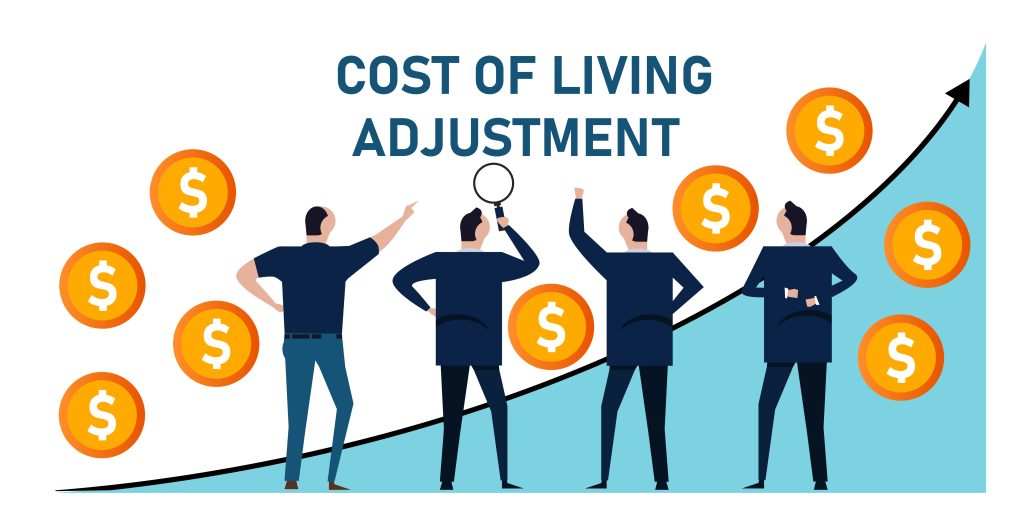Looking for Expert-Level VA Claim Answers?📱Call Us Now! 737-295-2226
Yes, the latest 2025 COLA increase estimate is a 2.5%, which will be applied to VA disability compensation rates effective December 1, 2024, payable beginning January 1, 2025.
Our latest 2025 COLA prediction has slightly decreased (yet again) following a lower-than-expected August 2024 CPI report, indicating further cooling of inflationary pressures.
If inflation continues to slow with just one month to go, the Cost of Living Adjustment (COLA) for 2025 could be lower than the current projection of 2.5%.
Table of Contents
What is a Cost of Living Adjustment (COLA)?

A Cost-Of-Living Adjustment (COLA) is calculated automatically each year and is intended to reflect the change in the cost of living over a one-year period.
The primary purpose of a COLA increase is to help consumers maintain their spending power relative to inflation.
The Consumer Price Index for Urban Wage Earners and Clerical Workers (CPI-W), which is updated monthly by the Bureau of Labor Statistics (BLS), is the measure used to calculate whether there will be a COLA increase.
The CPI-W is an estimate of the average change in prices of the goods and services purchased by households whose incomes come primarily from clerical or wage occupations.
The BLS measures the price change of each item in a “basket” of goods that the average person purchases, and then it computes overall inflation (weights each of those price changes by the item’s share of spending).
What is the 2025 COLA Increase Based On?

The 2025 Social Security COLA is based on the percentage increase from the highest third quarter average CPI-W recorded from 2023 compared to the average CPI-W for the third quarter of the current year (3rd quarter 2024).
The percentage increase is rounded to the nearest one-tenth of 1% (0.1%).
If the CPI-W triggers a 2025 VA disability COLA this year, it becomes effective December 1, 2024, and is payable starting January 1, 2025.
In some years; however, the CPI-W does not increase.
In fact, sometimes a decrease has been recorded (e.g., 2010, 2011, and 2016).
In those years, no COLA was payable as required by law, which means the increase was zero.
The COLA can never be negative even during times of a decreasing price index.
What is the Cost of Living Increase for 2025?

The latest 2025 COLA estimate is now 2.5%, but with inflation slowing faster than expected, the final adjustment could be even lower.
In mid-October 2024, the Social Security Administration (SSA) will announce the 2025 Cost of Living Adjustment.
If inflationary pressures continue to ease in the U.S. economy, it’s possible that the 2025 COLA will be less than 2.5%.
We won’t know for sure until the third quarter of this year (2024).
How Do You Calculate a COLA Increase?

We won’t be able to officially calculate the 2025 COLA increase until the third quarter CPI-W data gets released in the fall of 2024.
But we can use 2023 as an example of how the COLA rate gets calculated each year, and plug-and-play the new CPI-W data as soon as it’s released.
The Formula to Calculate a COLA Increase
- First, we need to calculate the Average CPI-W Index Points for Third Quarter of 2022 (rounded to the nearest one-thousandth of a point), which was 291.901.
- Second, we need to calculate the Average CPI-W Index Points for the Third Quarter of 2023, (rounded to the nearest one-thousandth of a point), which was 301.236.
- Finally, take the percentage “increase” or “decrease” from the third quarter average for 2022, compared to the third quarter average for 2023, and multiply by 100% (rounded to the nearest one-tenth of 1% for the final application, when positive, as required by law.)
➡️ The final COLA calculation for 2024 looked like this: ((301.236 – 291.901) / 291.901) * 100% = 3.2%.
Source: Bureau of Labor Statistics (BLS) data series for the Consumer Price Index for Urban Wage Earners and Clerical Workers (CPI-W) for 2022 and 2023. View the data here.
How We Estimated Our 2025 COLA Increase
- First, we need to calculate the Average CPI-W Index Points for the Third Quarter of 2023, (rounded to the nearest one-thousandth of a point), which was 301.236.
- Second, we need to estimate the Average CPI-W Index Points for the Third Quarter of 2024, (rounded to the nearest one-thousandth of a point), which is 309.100.
- Finally, we took the percentage “increase” from the third quarter average for 2023, compared to the third quarter estimated average for 2024, and multiply by 100%.
➡️ The final COLA for 2025 could look like this: ((309.100 – 301.236) / 301.236) * 100% = 2.5%
Source: Bureau of Labor Statistics (BLS) data series for the Consumer Price Index for Urban Wage Earners and Clerical Workers (CPI-W) for 2023 and 2024. View the data here.
Can There Be No COLA Increase?

Yes, there can be no COLA increase.
Since automatic Social Security Benefit COLAs began in 1975, there have been three years where no COLA was payable: 2010, 2011, and 2016.
The Social Security Act specifies that a COLA is payable automatically if the average CPI-W for the third quarter of the current year is higher than the highest average CPI-W for the third quarter of past years, which is called the “cost-of-living computation quarter.”
If the average CPI-W for the third quarter of the current year is equal to or less than the average CPI-W for the cost-of-living computation quarter, no COLA is payable.
What Programs Are Impacted by COLA?

Cost-of-Living Adjustments (COLA) impact a range of programs, primarily those that provide income or benefits to individuals.
The aim of COLA is to ensure that the purchasing power of recipients does not erode over time due to inflation.
Here are some key programs impacted by COLA:
- Social Security Benefits: One of the most well-known applications of COLA. Social Security payments are adjusted annually to reflect the cost of living increases.
- Federal Civil Service Pensions: Similar to Social Security, federal pensions often include COLA provisions to protect retirees’ purchasing power.
- Military Retirement Pay: Military retirees receive COLA adjustments to their retirement pay to help keep up with inflation.
- Supplemental Security Income (SSI): SSI benefits, which provide financial assistance to individuals who are disabled, aged, or blind, are also subject to annual COLA increases.
- Veteran Benefits: Various veteran benefits, including disability compensation, pension, and special monthly compensation payments receive annual COLA adjustments.
- Federal and State Minimum Wage: Some jurisdictions automatically adjust their minimum wage levels based on inflation, which is a form of COLA. However, this is not uniform across all states or at the federal level.
- Food Stamps (SNAP Benefits): The maximum benefit amounts and income eligibility thresholds for the Supplemental Nutrition Assistance Program (SNAP) are adjusted annually for inflation.
- Medicare: Parts of Medicare, such as Part B premiums, are sometimes adjusted based on costs, which can be influenced by inflation, although this is not a direct COLA in the same way it is applied to Social Security benefits.
- Railroad Retirement Benefits: Similar to Social Security, these benefits include a COLA.
What VA Benefits Will be Impacted by a 2025 COLA Increase?
These cash benefits will be impacted by the official 2025 COLA for VA disability:
- VA Monthly Compensation
- VA Special Monthly Compensation (SMC)
- VA Pension
- VA Survivors Pension
- Dependency and Indemnity Compensation (DIC)
- The Medal of Honor Pension
- VA clothing allowance
- VA automobile allowance
Recent COLA for VA Disability
- 2020: 1.6%
- 2021: 1.3%
- 2022: 5.9%
- 2023: 8.7%
- 2024: 3.2%
2023 saw the biggest increase in the COLA for VA disability since 1981, which was a huge 11.2%.
Historical COLA Increases Since 1975
The table below shows historical COLA increases by year along with the COLA percentages since 1975:
| Year | COLA % | Year | COLA % |
|---|---|---|---|
| 1975 | 8% | 2001 | 3.5% |
| 1976 | 6.4% | 2002 | 2.6% |
| 1977 | 5.9% | 2003 | 1.4% |
| 1978 | 6.5% | 2004 | 2.1% |
| 1979 | 9.9% | 2005 | 2.7% |
| 1980 | 14.3% | 2006 | 4.1% |
| 1981 | 11.2% | 2007 | 3.3% |
| 1982 | 7.4% | 2008 | 2.3% |
| 1984 | 3.5% | 2009 | 5.8% |
| 1985 | 3.5% | 2010 | 0% |
| 1986 | 3.1% | 2011 | 0% |
| 1987 | 1.3% | 2012 | 3.6% |
| 1988 | 4.2% | 2013 | 1.7% |
| 1989 | 4% | 2014 | 1.5% |
| 1990 | 4.7% | 2015 | 1.7% |
| 1991 | 5.4% | 2016 | 0% |
| 1992 | 3.7% | 2017 | 0.3% |
| 1993 | 3% | 2018 | 2% |
| 1994 | 2.6% | 2019 | 2.8% |
| 1995 | 2.8% | 2020 | 1.6% |
| 1996 | 2.6% | 2021 | 1.3% |
| 1997 | 2.9% | 2022 | 5.9% |
| 1998 | 2.1% | 2023 | 8.7% |
| 1999 | 1.3% | 2024 | 3.2% |
| 2000 | 2.5% | 2025 | 2.5% (estimate) |
Source: SSA Cost-Of-Living Adjustments since 1975
About the Author

Brian Reese
Brian Reese is a world-renowned VA disability benefits expert and the #1 bestselling author of VA Claim Secrets and You Deserve It. Motivated by his own frustration with the VA claim process, Brian founded VA Claims Insider to help disabled veterans secure their VA disability compensation faster, regardless of their past struggles with the VA. Since 2013, he has positively impacted the lives of over 10 million military, veterans, and their families.
A former active-duty Air Force officer, Brian has extensive experience leading diverse teams in challenging international environments, including a combat tour in Afghanistan in 2011 supporting Operation ENDURING FREEDOM.
Brian is a Distinguished Graduate of Management from the United States Air Force Academy and earned his MBA from Oklahoma State University’s Spears School of Business, where he was a National Honor Scholar, ranking in the top 1% of his class.




